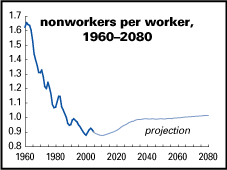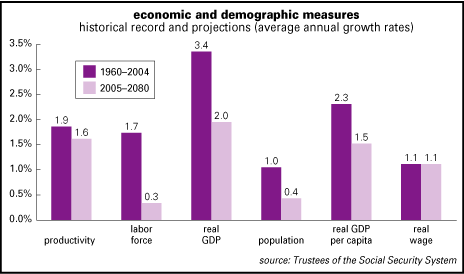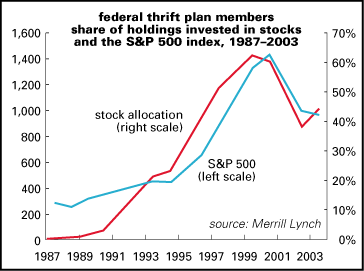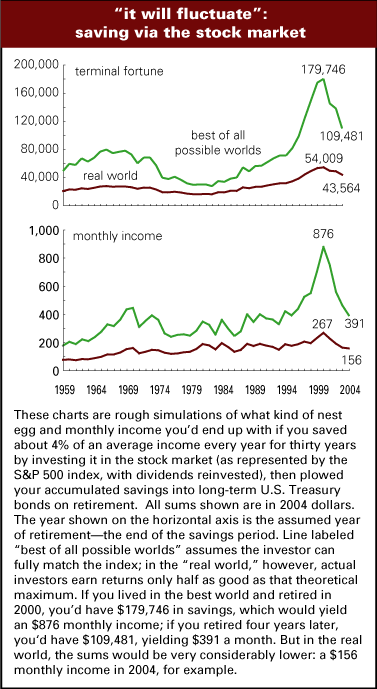
Home Mail Articles Stats/current Supplements Subscriptions Radio
The following article appeared in Left Business Observer #110, March 2005. It retains its copyright and may not be reprinted or redistributed in any form - print, electronic, facsimile, anything - without the permission of LBO.
Social Security, revisited
It's uncanny reading Paul Krugman's New York Times column these days—his stuff on Social Security sounds like what LBO was saying in 1998. His February 1 piece was all about how the Trustees of the Social Security system are projecting absurdly low economic growth rates, about half the long-term average, even though proponents of privatization assume that the stock market would continue to return its historical average. That couldn't happen, unless the standard measure for evaluating the dearness or cheapness of stock prices, the price/earnings ratio (which compares stock prices to underlying profits), were to scale unprecedented and ludicrous heights. The numbers Krugman used to illustrate the point are a bit different from LBO's seven-year-old vintage, but not by much.
It's nice to be vindicated, though one would always prefer it to be at Krugmanesque levels of name recognition. But, vanity aside, the transformation in the political discourse around Social Security over the last few years has been stunning. Views once espoused only in marginal newsletters now appear regularly on the op-ed page of our most prestigious newspaper. One reason for this, it must be conceded, is that in the 1990s, it was Clinton and the Democrats who were flirting with Social Security privatization, a scheme derailed by revelations of Clinton's tender encounter with Monica Lewinsky. Now that it's Bush proposing it, Democrats are showing a surprising level of resistance, and the polls on the subject can't make pleasant reading for the administration. There is some progress in political life despite last November's election results.
Not that there's any progress in the arguments of the privatizers, or the economic analysis on which the projections of Social Security's bankruptcy are based. And even Social Security's defenders are too quick to concede the system has "problems" that "need to be fixed." If Social Security has any problems in its current form, they won't become apparent for decades, and if they do, they could easily be dealt with. Conceding anything on this point only strengthens the hands of the privatizers, who are using fear of bankruptcy to promote an ugly and dangerous agenda.

First, the economic arguments, which are based on some fundamental demographic "facts." The U.S. population is aging. Birth rates aren't what they were during the Baby Boom, and the people born during those years (1946–64) will start joining the ranks of the official elderly starting in 2011. Today, about 12% of the U.S. population is 65 and over; the Trustees of the Social Security system, who make the official projections, see that rising to 18% in 2025, 21% in 2050, and 23% 2080. Sounds dire: since the pension benefits of today's retirees are paid by today's taxpaying workers, then the increasing ratio of old to young will put a burden on the retirement system—any retirement system, private as well as public, though that detail is rarely mentioned.
But how serious a problem is this? Nowhere near as serious on the second glance as the first. As with many of the projections, the Trustees' are considerably gloomier than those produced by other entities. The Census Bureau, for example, projects the 65-and-over share of the population to be less than 22% in 2080. That may not sound like much, but if the Census Bureau is right and the Trustees are wrong, that adjustment alone could reduce the system's projected deficit 75 years from now from 2.1% of GDP to 1.6%.
And looking only at the elderly share of the population is a very selective analysis. A broader analysis would ask how many nonworkers is each member of the paid workforce projected to support. In 2080, the Trustees project that there will be 1.01 nonworkers for every paid worker, up from 0.90 today (see nearby chart). But the 2080 figure is still way below 1955's 1.68, when there were many more kids running around, and many fewer women in paid employment than today. Even if you don't buy the nonsense about the New Economy's productivity revolution, it's hard to imagine why the U.S. economy of 2080 would have a rough time coping with the same nonworker/worker ratio that it did in the mid-1980s.
Speaking of that productivity revolution, it's nowhere in the projections. Over the very long term, output per worker in the U.S. has grown around 2% a year. Some reputable economists project that the infotech has kicked us up to a higher rate of 2.5% a year, though that seems like a stretch. (Some boosterish business pundits are even pushing an implausible 4% rate.) Lost in their gloomy world, the Social Security Trustees are projecting a 1.6% rate of annual productivity growth through 2080—20% below the long term average. Those differences might not sound like much, but they really compound over time. At 1.6% a year, productivity in 2080 would be almost 230% of today's levels; at 2.0%, over 340%; at 2.5%, almost 540%. Obviously, the bigger the number, the better the economy will be able to afford its retirees—but the Trustees chose a very small one.
Economic growth isn't only a matter of growth in productivity per worker; it's also determined by the growth in the labor force. And the Trustees project that the growth in the labor force over the next 75 years will be about one-sixth as fast as it was between 1960 and 2004. Some slowdown is likely, since women's entry into paid labor is a trend that may have run much of its course (though just 57% of adult women are working, compared with 72% of men, so that gender gap in employment hasn't closed any more than the pay gap has).
But the Trustees' projection represents a stunning drop from historical experience, and one that can only be partly explained by the 60% slowdown in population growth they foresee. (And one reason for the slowdown in population growth is that they also foresee a sharp dropoff in immigration—important, since immigrants tend to be young, making them net contributors to Social Security.) Oddly, they're projecting that the labor force will grow more slowly than the population, even though it's grown nearly twice as fast as population since 1960. Maybe the Trustees are implicitly projecting a breakdown in the American economy's prodigious powers at putting people to work—but if that's the case, it's a big deal, and we should really be talking more explicitly about it.

It's historically and theoretically inconsistent to project a slowdown both in labor force and productivity growth; across time and space, lower population growth has often resulted in higher productivity growth. If labor is plentiful, employers are less keen on squeezing more out of the workforce and are less likely to invest in capital equipment. But this inconsistency is fully consistent with the Trustees' outlook, which is as dark as a goth teen's worldview.
When you put all the Trustees' projections together, productivity and labor force growth, you get a sharp dropoff in projected GDP growth—from a historical average of 3.4% to an extremely sluggish 2.0%, which is little better than what we saw in the Depression-afflicted 1930s. If the Trustees really expect near-depression rates of growth for the next 75 years, we should be talking explicitly about that as well. Were the economy were to grow at a more normal pace, then the Social Security system could easily pay its projected benefits with no cuts or tax increases.
But no, reply the privatizers; if growth were higher, wage growth would be faster, and therefore benefits (which are keyed to wages) would also rise more quickly, so it'd all be a wash. Someone should tell the Trustees: they're projecting no dropoff in wage growth from now to 2080 despite the sharp drops in productivity and GDP growth. And someone should also tell U.S. employers that higher productivity growth means higher wages: workers have gotten only about 28% of the productivity acceleration since the mid-1990s in the form of higher wages. The rest has gone to profits, which is very nice if you're a CEO or a big stockholder.
These ludicrous statistical projections are only part of the elaborate con game that is the Social Security privatization marketing plan. Another is pretending that the scheme the administration presumably prefers (presumably because they've been rather quiet on the details) would somehow address the system's alleged financing crisis. It looks like Bush would allow workers to divert up to 4% of their salaries—roughly a third of the current 12.4% payroll tax, which is evenly divided between employees and employers—into private accounts, which could then be invested in the financial markets, especially that magic money machine, the stock market.
Such a scheme would worsen the system's fiscal position, not strengthen it. Since the benefits of today's retirees are paid with the taxes of today's workers, any diversion of revenues into private accounts would make Social Security checks start bouncing. Over time, as the holders of private accounts aged sufficiently to retire (and, no doubt, to discover how distressingly small those accounts turned out to be!), and started drawing on them rather than the public system, this problem would take care of itself. But the so-called transition costs would amount to several trillion dollars, spread over a couple of decades.
So, not only does privatization fail to address the alleged solvency problem, it makes it worse. Privatizers dismiss this with stunning leaps of illogic. In an appearance before the Council on Foreign Relations in New York on January 28, former Bush economic advisor Glenn Hubbard (more on him in a moment) likened the transition costs to "prepaying part of a mortgage." Hubbard neglected to note that this prepayment would almost certainly be made with borrowed money, not some unexpected income windfall. And these are additional costs created by privatization, not some inevitable expense down the road.
Yet another turn of the privatizers' confidence game is to cut benefits—not directly, but by the arcane trick of changing the index by which pension benefits are adjusted over time. Currently, they're adjusted annually in line with the growth in the average earnings of workers paying into the system. People who think for the administration have proposed switching to a price index for the adjustment. That may not sound like much, but according to Social Security's chief actuary, that switch would result in a 26% cut in benefits from currently projected levels for workers retiring in 2042, and a 46% cut for those retiring in 2075. People are hardly living it up on their Social Security benefits now; cuts of this magnitude would be horrific.
Privatizers always point to the stock market as the alternative to the public pension system. It's already been pointed out that should economic growth be as weak as the Trustees project, it's highly unlikely the market could perform at anything like its historical averages. But let's bracket that for the moment and consider seriously how the stock market might treat real amateur investors.
The standard trick is to look at the performance of an index like the S&P 500 over the very long term and say something like, "stocks return an average of 7% a year after inflation." That's true in some sense, but it's not clear just how relevant that number is. Over all the 30-year periods since 1871, an approximation of a savings lifetime, average real returns have ranged from 2.7% to 9.8% . But almost no one matches the averages. Professional money managers generally fall a little short, and most small investors have to rely on the pros. And the pros charge management fees, which eat into individuals' returns. But that's not the only problem: most individuals do not make stellar investment decisions.

A Merrill Lynch study (results graphed above) of the federal employees' pension system, whose choice of a variety of mutual funds is considered a model for a privatized Social Security, found that workers' level of investment in stocks moves up and down with the market; in the years after the 1987 crash, federal workers had almost no money in stocks; at the 2000 peak, they had over 60% in stocks. This is in line with the Wall Street adage that it's not that buying leads to rising stock prices—it's the rising prices that lead to the buying.
Graphed below are some simulations of savings lives over the years. They assume that workers can invest about 4% of their incomes in the stock market over the course of 30 years. On retirement, they plunge their savings into long-term U.S. Treasury bonds and try to live on the income.
As the chart shows, the numbers are all over the place. Someone retiring at the peak of the bull market in 2000 could have a monthly income of $876—but that was more than cut in half four years later, to $391. As the chart shows, the 2004 number is close to the long-term average, before things got wacky in the mid-1990s. And those incomes aren't indexed to inflation, which could knock 20–30% off their real values in a decade.
Ah, but those are purely theoretical numbers. Just subtracting a rather modest 0.5% management fee would reduce monthly income by an average of 11%; a 1% fee, by 18%. More stunning, though, is the real-world adjustment—if investors earned half as much as the S&P 500 index, they'd get a monthly check for an average of $150 (and all these numbers are 2004 dollars). Sure the bubble brought it up to $267 at the peak, but that was a bubble. And if the economy were to grow at Trustee-approved rates of sluggishness, even these would look like big numbers.

The numbers are low, but they're also volatile. People retiring just five years apart could have incomes ratios of nearly two to one separating them—which seems unjust, and also likely to provoke family conflict.
Some of the more sophisticated—or clever, to be more precise—privatizers argue that channelling new money into stocks will increase corporations' investment in plant and equipment, and thereby raise economic growth rates. There's absolutely no reason to believe that. Almost all stocks are bought from other stockholders; initial offerings, the only case when stock purchases find their ways into corporate treasuries, are generally rare and small. A comparison of the relation between the size of private pension funds and the investment levels across several major countries shows no significant correlation at all. And when you look at the size of the pension funds' stockholdings, the relation is the opposite of what you'd expect: the higher the level of stockholding, the lower the level of investment spending.
The ludicrously dire projections for Social Security's future only make sense when they're considered as part of a massive propaganda campaign to promote the privatization of Social Security, a long-standing obsession of the U.S. right largely unshared by the broader population. Polls show large majorities in favor of leaving the system largely as it is—even among the young, who are more friendly to the idea of private accounts than the middle-aged and elderly. Polls also show the public with far more pressing economic concerns, like low wages, scarce jobs, and rising health insurance costs. So people must be scared into giving up Social Security.
Rarely is the political thinking behind Social Security privatization expressed bluntly; it's usually wrapped in a lot of blather about "choice" and "ownership." An exception to the rule of euphemism was former Bush economic advisor Glenn Hubbard's appearance before the Council on Foreign Relations. Hubbard, now a dean at Columbia, said: "If we were to start afresh thinking of Social Security today, I strongly suspect what we would have is a program that had a very substantial guaranteed benefit for low-income people, and a variety of things that narrowed that down for middle- and upper-income people, replacing those with a combination of personal accounts and savings incentives." It's hard to take the "very substantial" bit very seriously, but the major point is that the right is dying to transform the system from a universal one into one targeted at the poor, with the rest of us expected to fend for ourselves. Cutting benefits by switching to a price index would promote this goal, without having to come out and say it directly.
Hubbard said something rather similar about Medicare: "[I]f were to start today in a room like this [one full of bankers, lawyers, and elite pundits — ed.] and decide we've never had Medicare—we're thinking about how to do it—we would probably have some sort of forced savings scheme where people saved up money in their individual accounts, and then were required to buy health insurance in old age, and we'd probably help low-income people do that." As the old adage goes, programs for the poor are poor programs, a maxim confirmed by international comparisons of universal vs. targeted systems. Universal systems, whether for pensions or health care, are more generous and politically more bulletproof than targeted ones. Rightwingers understand this well; liberals don't.
Standard anti-government ideology to the contrary, Social Security and Medicare work very well: they largely accomplish the tasks they set out to, and do so at administrative costs far lower than their private-sector counterparts.
Hacks like Hubbard like to lump together Social Security, Medicare, and Medicaid into a single entity with the unpleasant name "entitlements," a word that conjures up images of demanding narcissists, and not the old and the sick. In fact, Social Security is a minor league problem, if it's a problem at all, next to health care finance. Even if the official projections are true, the Social Security problem, if it's a problem, represents a cost about one-third the Bush tax cuts if they were to be made permanent, as the president and many Republicans wish. Our rich were hardly suffering in 1999, and returning to those levels of taxation would be barely noticeable to most of us.
Medicare and Medicaid do, however, represent serious fiscal burdens—but they're subsets of our broader health-care financing crisis, and can't be fixed in isolation. The only approach to that that makes any sense is a single-payer national health insurance system, which is hardly in the cards—especially while the likes of Hubbard are jabbering about making competitive markets work in medicine.
Single-payer seems like an impossible dream right now, when we're busily trying to preserve the social gains of the 1930s (though if the polls are to be believed, it wouldn't be all that hard a sell to the broad public). But it's been encouraging to see the president's privatization scheme run into serious trouble, not only with public opinion, but also in some corners of elite opinion and even among Republicans in Congress. The privatizers are not going to give up easily, however; Wall Street stands to make too much money on a privatized system, and rightwingers stand to make too many ideological points just to roll over. Now's not the time to concede anything. Social Security's fine, and will be for decades. If it needs a "fix," it won't be for 30 or 40 years. It's urgent to save the system—not only for the material well-being of the elderly, but to preserve some of our last notions of social solidarity against the I–me–mine ethic of the marketizers. And for once, the task doesn't look hopeless.
Home Mail Articles Stats/current Supplements Subscriptions Radio